Margaux’s Wine of the Vintage?
Our latest article takes a closer look at one of the final entries in the Place de Bordeaux’s September 2021 Campaign, as we examine Palmer’s re-release from one of Bordeaux’s most challenging recent vintages.
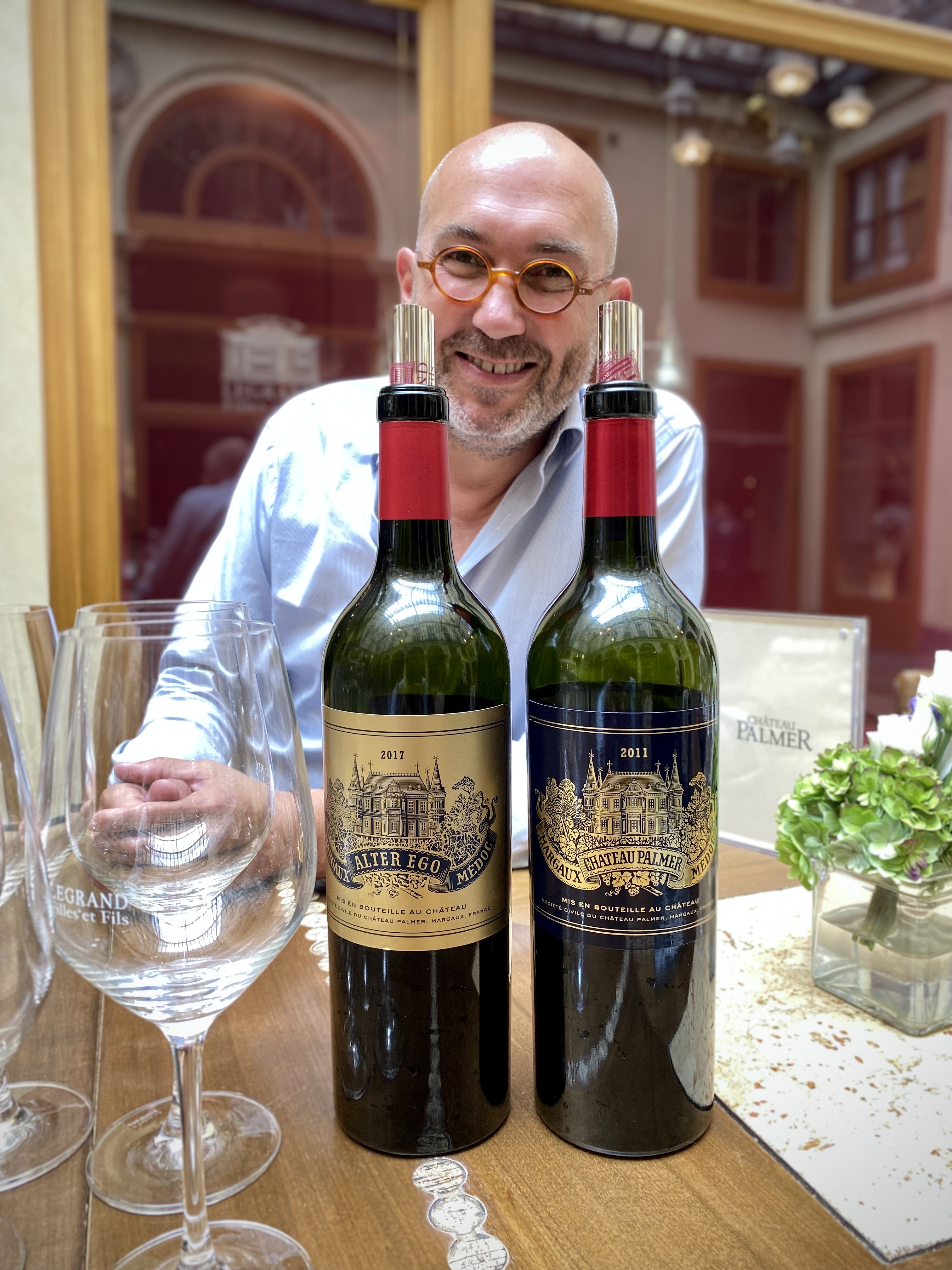 Palmer’s Director, Thomas Duroux tasting Palmer 2011 and Alter Ego 2017 with Wine Lister CEO, Ella Lister
Palmer’s Director, Thomas Duroux tasting Palmer 2011 and Alter Ego 2017 with Wine Lister CEO, Ella Lister
What is the story behind Palmer’s 2011 vintage?
Palmer’s precious secrets
A decade on from production, Thursday 23rd September saw the re-release of Palmer 2011 with a recommended UK onward selling price of £228 per bottle (in-bond). This release represents the second instalment of their ‘10 years on’ series, which presents decade-old ex-château stocks to the market via the Place de Bordeaux. While still releasing Palmer’s latest vintages en primeur, the estate’s Director, Thomas Duroux tells Wine Lister CEO, Ella Lister that withholding stock for ex-château release for 10 years plays tribute to Émile Peynaud’s philosophy that “A great wine needed at latest 10 years of age before it was ready to drink”.
The story of a peculiar vintage
Building momentum amongst merchants and collectors for the release of a notoriously challenging vintage is no mean feat. Duroux’s deft storytelling played on the strengths of Palmer’s historically low yields, reminiscing the events of this curious vintage to encourage interest in the re-release. With a mere 20 hl, the 2011 produced less than half the yield of a normal year, and the even-greater scarcity of re-release availability (approximately 1,000 cases) was surely designed to entice further demand. Several Bordeaux properties suffered at the hands of a significant hailstorm on 4th June 2011, with some falling victim to damage in the crucial berry set period. Although Palmer felt the effects of the growing season, it nonetheless still produced a well-scored wine, matching the average WL score of first growths Margaux, Lafite, and Mouton (93).
Crunch time
Duroux links the quality of their 2011 to the somewhat merciful timing of the hailstorm. Having passed through flowering, the berries were small and able to withstand the storm’s impact, with the damage sustained mostly by the vine’s young shoots. Since the vines compensated by rerouting their energy to grow new shoots, they devoted less energy to fruit development, therefore the harvest yielded a smaller collection of concentrated berries. Such details serve as a good reminder, that the story of a vintage can only paint a partial (and general) picture – digging into the detail of each estate can uncover so much more potential.
Key fine wine releases from Bordeaux and Beyond
As another week of releases draws to a close, we reflect on highlights from the past fortnight, including the latest vintages of signature New and Old World wines, offered through the Place de Bordeaux’s impressive network.
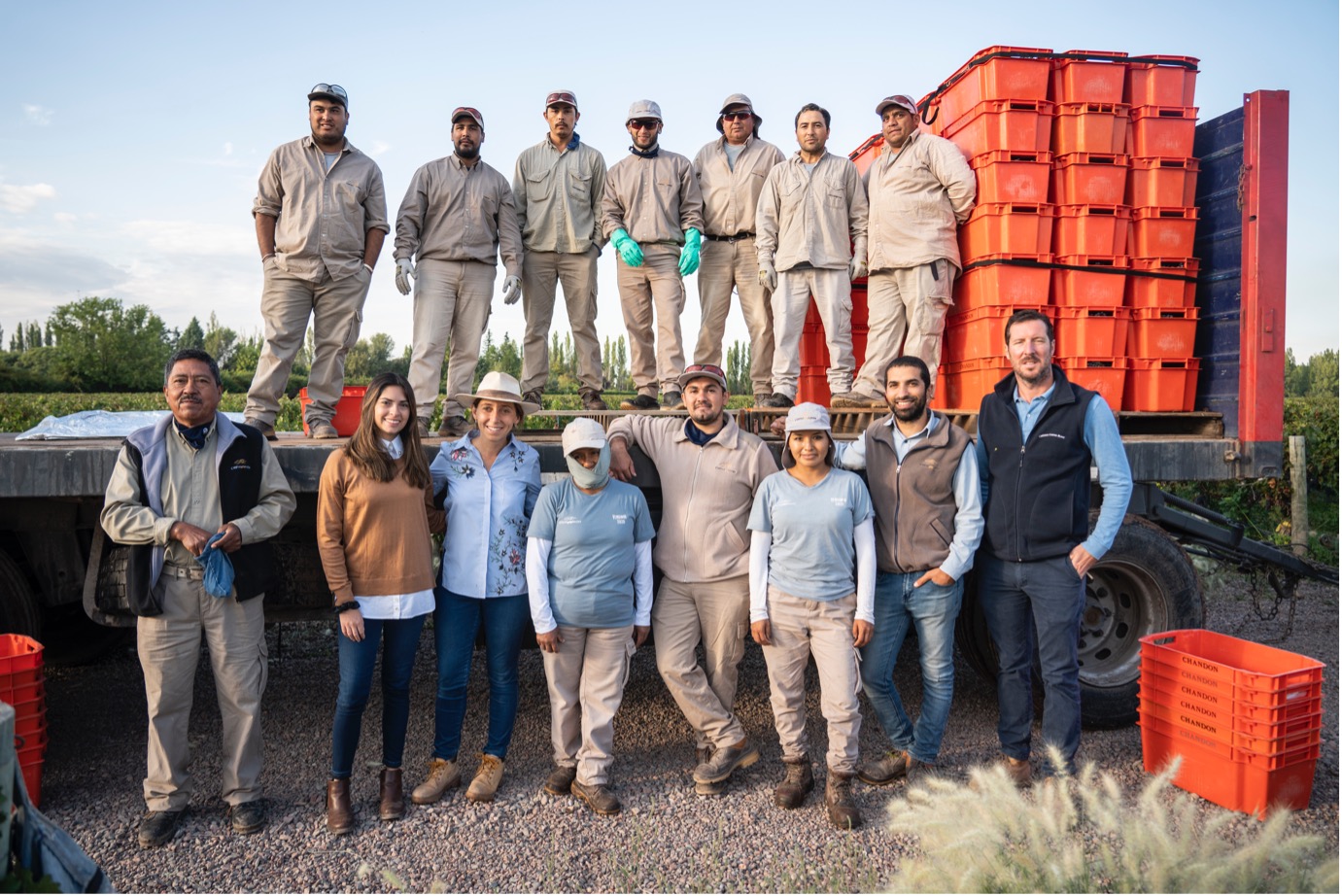 Cheval des Andes’ Technical Director, Gerald Gabillet (bottom right), with the winemaking team
Cheval des Andes’ Technical Director, Gerald Gabillet (bottom right), with the winemaking team
Which wines offer the best investments from the Place de Bordeaux’s September campaign?
As well as a further flurry of releases from the Americas and Tuscany, the past two weeks have also witnessed exciting French entries from the likes of the Rhône Valley, and a re-release of Latour 2005.
California dreaming
One of the top 20 fine wine brands in the world (according to its Wine Lister Pro Brand score), Opus One released its 40th vintage, 2018 last Monday (6th September), at £230 per bottle (in-bond). Wine Lister partner critic, Antonio Galloni (Vinous) gives the latest release a score of 95, describing it as “incredibly elegant and polished, right out of the bottle”.
Napa Valley neighbour, Beaulieu Vineyard’s Georges de Latour Private Reserve 2018 was released on Tuesday (14th September) at £115 per bottle (in-bond). Describing the wine as “sensational”, with notes of “inky red fruit, chocolate, leather, and liquorice”, Galloni gives the latest vintage 98 points – its joint-highest score ever awarded by the critic body. Joseph Phelps’ Insignia 2018 entered the market in quick succession on Tuesday at £163 per bottle (in-bond). Sampled by Wine Lister COO, Chloe Ashton at a recent tasting at 67 Pall Mall (alongside the 2010 and 1998), she found the evolution in complexity, tension, and precision was clear to see.
Monday (13th September) witnessed a triptych of 2018s from Sonoma County’s Vérité, with La Muse, Le Désir, and La Joie released onto the market at £300 per bottle each (in-bond). With the wines representing distinct expressions of the estate through the bespoke blending of different varietals and plots, the Merlot-based La Muse receives a perfect 100-point score from Lisa Perrotti-Brown for Wine Advocate, who calls it “Electrifying!”. Comprising a majority blend of Cabernet Franc, Le Désir gains 97+ and 97 points from Perrotti-Brown and Suckling, respectively. Whilst being Wine Lister CEO, Ella Lister’s favourite amongst the three, the Cabernet Sauvignon-dominant La Joie 2018 secures its highest average critics scores since 2013, inclusive of 98 points from Perrotti-Brown and 99 points from Suckling.
South American sensations
Leading last week’s South American entries, Baron Philippe de Rothschild’s Chilean winery Almaviva released its 2019 vintage on Wednesday (8th September) at £108 per bottle (in-bond). The Wine Lister team found it to show good complexity for its young age, with dense black fruit, exotic spices, and a touch of hay smoke.
Across to Argentina, Cheval des Andes 2018 was released on Thursday (9th September) at £59 per bottle (in-bond). The latest vintage aligns with the estate’s upward quality trajectory in recent years, having been awarded a score of 98 from James Suckling, who describes it as “very long and structured, yet controlled and in balance”.
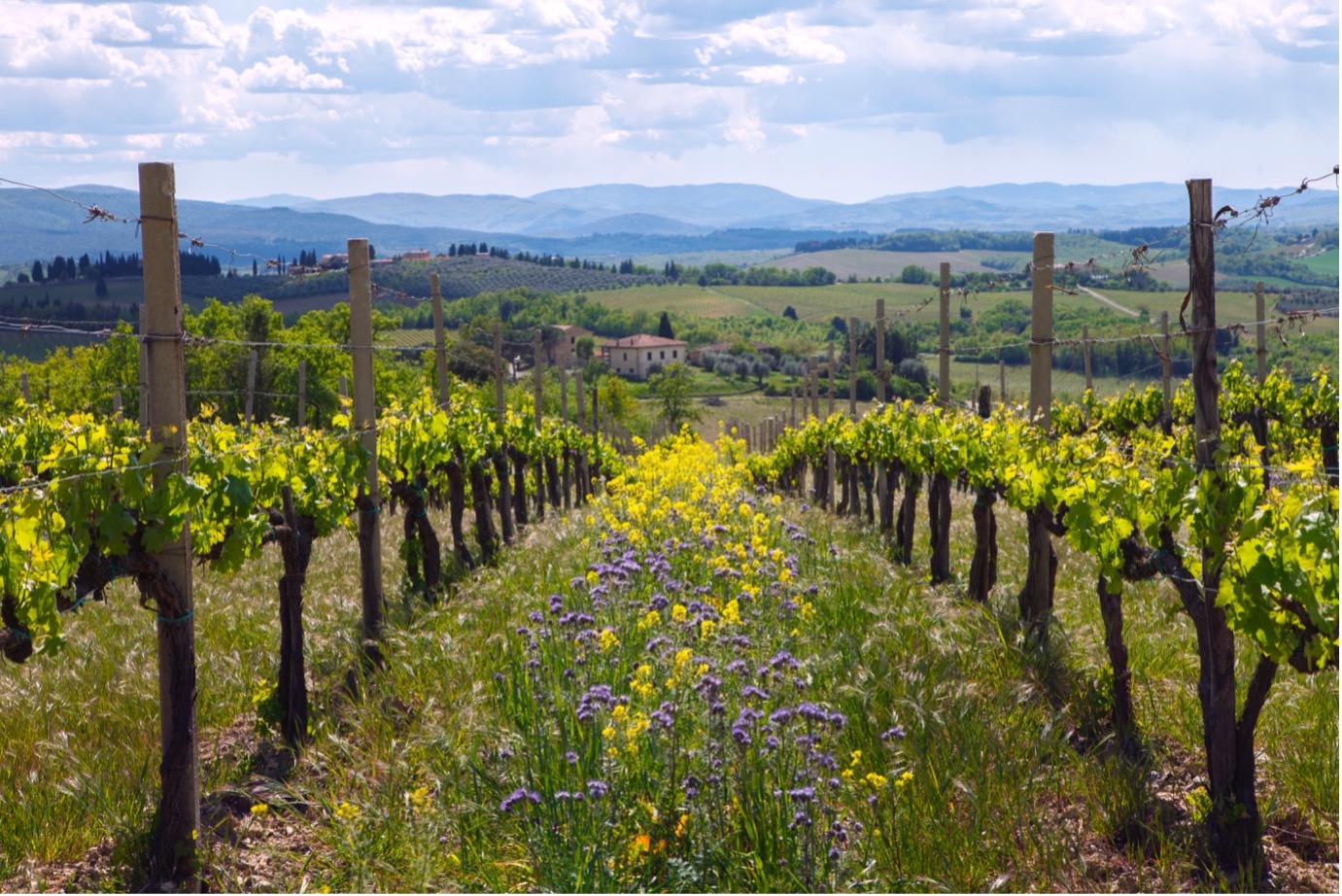 Wildflowers growing in-between Siepi’s Merlot and Sangiovese vines
Wildflowers growing in-between Siepi’s Merlot and Sangiovese vines
A Tuscan triumph
There are now only limited remaining stocks of Masseto 2018, which was released on Tuesday (7th September), starting from £495 per bottle (in-bond). The estate saw one of the rainiest springs in its history, and consequentially faced high levels of disease pressure. Nonetheless, the team at Masseto handled challenges that arose deftly, reflected in Wine Lister’s praise of its dense, layered, and lithe texture.
Now with similarly limited availability at around £208 per bottle (in-bond), Solaia 2018 was released on Thursday (9th September). Galloni awards it a strong score of 98, noting that he “can’t remember ever tasting a young Solaia with this much sheer appeal and balance”. Demand for the 2018 may well be encouraged by the estate’s positive price performance track record, which has seen some of its top-scoring vintages appreciate significantly post-release.
The first of the Tuscan trio to be released last week was Petrolo’s Galatrona 2019, which entered the market on Monday (13th September) at £72 per bottle (in-bond). Gaining a near-perfect score of 99 points from Suckling, he describes it as “muscular, yet agile” – “a unique definition of merlot in Tuscany”. Following in close succession, Castello di Fonterutoli released Siepi 2019 at £68 per bottle (in-bond). The Mazzei family planted its first Merlot grapes in 1980, with Siepi’s varietal blend now comprising equal proportions of Merlot and Sangiovese. The 2019 gains 98 points from Suckling – the joint-highest score awarded by the critic, who praises its “super-structure”, and “finesse with power”. To end Monday’s Tuscan trilogy, Tenuta Sette Ponti’s Orma 2019 was released at £56 per bottle (in-bond). Though Orma is yet to be widely scored by critics, Suckling awards it 97 points, calling it “perhaps the best Orma ever”.
Closing this week’s Italian offerings, Caiarossa 2018 entered the market on Wednesday (15th September) at £35 per bottle (in-bond). Walter Speller for Wine Lister partner critic, JancisRobinson.com, awards it 17+ points, considering it “classy stuff”, “which should become even more compelling with further bottle ageing”.
Back on French soil
Speculated to be the final commercial release of the vintage, Latour released a parcel of its 2005 vintage last Tuesday (7th September), which has since been offered by merchants for around £750 per bottle (in-bond). The 2005 was awarded 100 points by Galloni, who calls it “deep and sensual to the core”, and notes that it is “utterly captivating”. The iconic reputation of both the vintage and the estate is reiterated in this perfect score, which should stimulate interest from serious fine wine collectors.
Racing over to the Rhône, Beaucastel Hommage à Jacques Perrin 2019 was released last Friday (10th September) at around £227 per bottle (in-bond). A cask sample score from Alistair Cooper for JancisRobinson.com signifies quality, awarding its highest score from the critic body since 2007 with 19 points, calling it “One to watch!”.
Click here to sign up to Wine Lister’s newsletter to stay up-to-date with the latest from the Place de Bordeaux’s September campaign.
New World icons join top Tuscan wines for the first week of releases
A trading system used to distribute Bordeaux wines for almost 800 years, the Place de Bordeaux has, in more recent years, provided an international stage for many wines originating beyond its own borders. The first non-Bordeaux bottle to join La Place in 1998 was Almaviva, followed by Opus One in 2004, Masseto in 2008, and Solaia in 2009. Over the past decade, a further flurry of eminent estates from around the world have joined the distribution network, and together they form a campaign of new vintage releases every September.
 Seña and Chadwick owner, Eduardo Chadwick, and daughter, Magui
Seña and Chadwick owner, Eduardo Chadwick, and daughter, Magui
Which fine wines were released through the Place de Bordeaux this week?
South American superstars
Clos Apalta 2018 kicked off this year’s campaign on Tuesday 31st August, at £71.50 per bottle (in-bond). At this year’s CVBG London tasting at Berry Bros. & Rudd, Wine Lister enjoyed the elegance of the latest release, which boasted red fruits, pepper, and a hint of smokiness on the nose, and a fresh acidity and energy on the palate. Another vintage that adheres to the estate’s impressive quality consistency over the past five years, demand for the 2018 is further encouraged by Clos Apalta’s status as one of Chile’s leading wine brands.
Across the Andes, Catena Zapata released its 2018 vintage on Wednesday 1st September, with Nicolàs Catena Zapata entering the market at £53 per bottle (in-bond). Having gained 96 points from Joaquín Hidalgo for Wine Lister partner critic Vinous.com, the latest vintage achieves its highest ever-score from the critic outfit. He calls it “breathtaking”, with “layers of aroma, beginning with black currant and moving on to intense, precise notes of lavender and mint along with hints of black tea, sage and cigar box”.
Released yesterday (Thursday 2nd September) at £80 per bottle (in-bond), Seña 2019 was the product of a “long, stable ripening season”, according to owner, Eduardo Chadwick. Tasting with Wine Lister on Zoom, he explains that while “January did begin warmer than usual, summer in March was cooler than normal”, retaining freshness. Indeed, our team found the 2019 to be beautifully balanced, perfumed with muddled berries, sweet spice, and promising complexity of cherries and rustic earth, with satin tannins, on the palate. Supplemented by its high quality, the special-edition 25th-anniversary bottling should stimulate interest in Seña’s latest offering.
Describing Viñedo Chadwick 2019 as “one of the best recent vintages”, Eduardo tells us that, as ever, the character of the wine is shaped by the estate’s altitude. He explains that the great diurnal range throughout the warm growing season allowed freshness, encouraging what Wine Lister found to be both remarkable lift and flavour intensity, with aromas of iris, fresh herbs, and blackberry. Released onto the market at c.£230 per bottle, the 2019 was awarded 99 points by James Suckling, who echoes the sentiment that the wine is “refined, yet powerful”.
South African sweetness
On Wednesday 1st September, Klein Constantia released its Vin de Constance 2018 at £41 per bottle (in-bond). Wine Lister tasted the latest release on Zoom alongside Winemaker, Matt Day, and found notes of citrus and stone fruits complemented with notes of ginger on the nose, complete with a generous and balanced palate with a lightness and freshness that defies the stereotypes of “sweet wine”. Matt told us he believes the vintage represents an embodiment of his “fine-tuned” craft, which also coincided with “a perfect [growing] season”, encouraging the continuation of its positive quality trajectory this year. Indeed, the latest release (as yet not scored by any Wine Lister partner critics) gains 98 points from James Suckling in his most recent tasting.
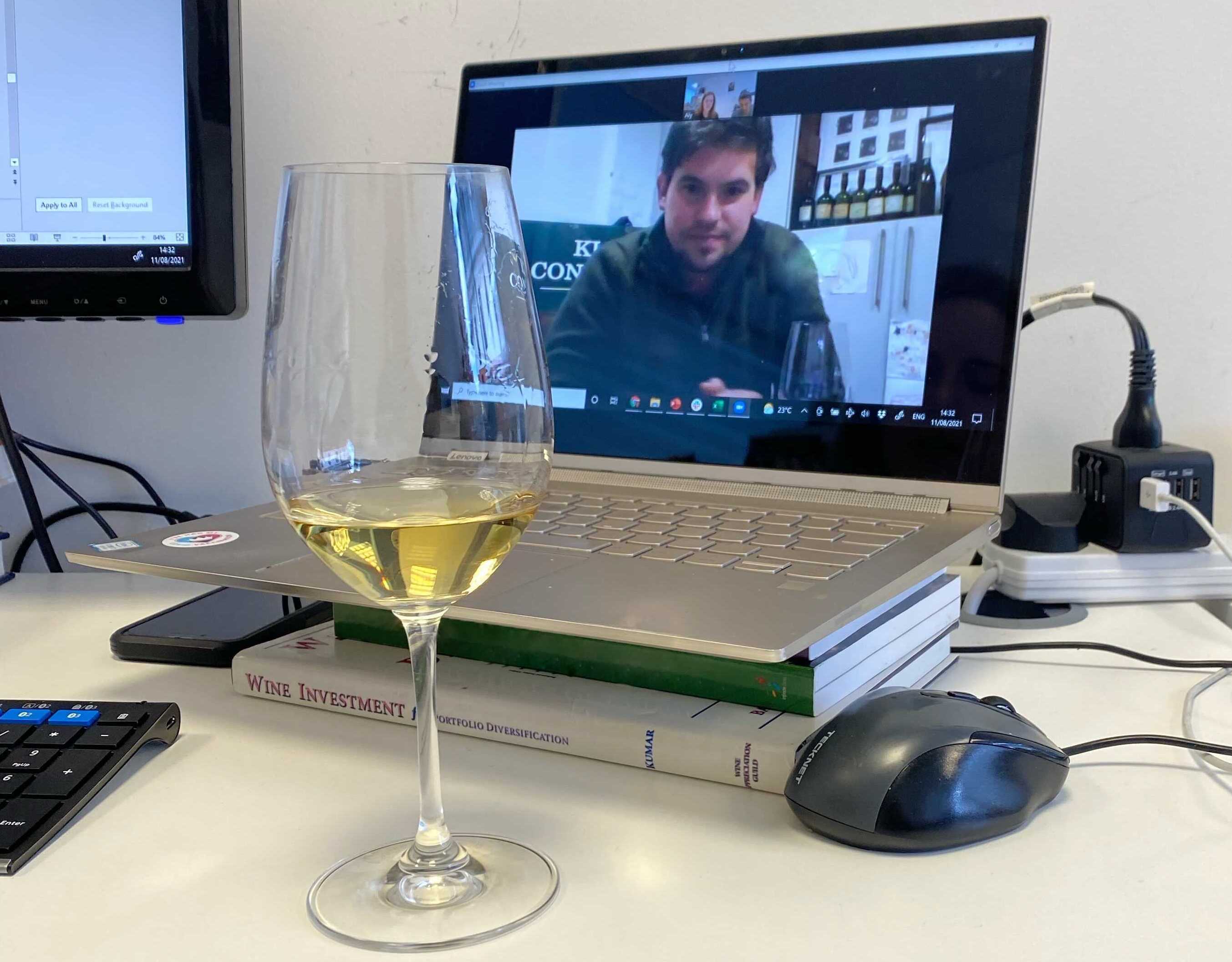 Tasting Vin de Constance 2018 alongside Klein Constantia Winemaker, Matt Day
Tasting Vin de Constance 2018 alongside Klein Constantia Winemaker, Matt Day
Top Tuscan offerings
Bibi Graetz’s Testamatta and Colore 2019 entered the market yesterday (Thursday 2nd September), at £73 and £180 per bottle (in-bond), respectively. Marking its 20th anniversary vintage, both wines feature special-edition bottles designed by artist turned vigneron, Bibi Graetz, with colour and text applied directly onto the glass. Wine Lister was particularly impressed with Colore 2019, which boasted a perfumed nose of violets, frangipane, and crushed berries, following through to a vibrant and juicy palate with silky tannins.
Wines likely to be released through the Place de Bordeaux next week include: Opus One 2018, Overture NV, Masseto 2018, Massetino 2019, Latour 2005, Almaviva 2019, Epu 2019, Cheval des Andes 2018, Solaia 2018, and Beaucastel Hommage à Jacques Perrin 2019.
Wine Lister speaks to 10 top sommeliers to find out more about their bottles of choice
 From left to right: Lupo Theones, Victor Petiot, Gareth Ferreira, Beatrice Bessi, and Paul Lo
From left to right: Lupo Theones, Victor Petiot, Gareth Ferreira, Beatrice Bessi, and Paul Lo
What top wines do sommeliers recommend?
Whether offering the perfect food pairing or serving an unforgettable glass, sommeliers are often responsible for creating moments of vinous magic shared by wine lovers far and wide. Our latest blog flips the script, with some of the world’s leading sommeliers sharing with us their most memorable pours, providing the ultimate guide on how to drink like a pro.
Read our blog on your favourite winemakers’ favourite wine for more insight into what the experts are drinking here.
Lupo Theones – Head Sommelier at Hélène Darroze at The Connaught, London
Lupo Theones shares the same sentiment as many of his peers: “it is challenging to choose a single wine when you taste so many great wines as a sommelier”. He nonetheless mentions Egon Müller’s Scharzhofberger Riesling Kabinett 2011 as a wine that “deeply impressed” him, having tasted it soon after moving to London to join The Connaught. Describing a “perfectly balanced” palate that “shows a great acidity and minerality”, Lupo notes that it is a wine you can drink on its own, or paired with the likes of sushi and shellfish, as well as Foie Gras.
Victor Petiot – Wine Director at Caprice at Four Seasons, Hong Kong
Having discovered the vintage just last year, Victor Petiot cites Toro Albalá Don PX 1931 as his favourite wine, due to its “uniqueness” after sleeping in barrel for over 90 years. He explains that it provides “the perfect balance between powerful and well-balanced” with a “sweet and creamy texture yet high acidity”. On the topic of pairing, Victor tells us that the wine prompted the creation of a new dish to be served with it, comprising “a pigeon cooked in a coffee dough with salsify, hazelnut, pan-fried foie gras and pigeon sauce with coffee and a bit of Toro Albalá 1931”.
Gareth Ferreira – Head Sommelier at Core by Clare Smyth, London
Gareth Ferreira recalls being “immediately hooked” on his first real trip to visit the great producers of Burgundy during his early career. He tells us of the first time he tried Jean-Marie Fourrier’s Gevrey-Chambertin Clos Saint-Jacques, which made him question, “how can wine taste this good?”. It has since remained a wine he “looks forward to opening, no matter what the vintage is”, though the first he tasted – 2009 and 2010 – “will always have a special place in [his] heart” and 2002 is one of his favourites in Burgundy.
Beatrice Bessi – Head Sommelier at Chiltern Firehouse, London
“The reason that I became a sommelier is the Nebbiolo grape” exclaims Beatrice Bessi, who fell in love with Barolo in particular over 10 years ago. It is her “never-ending love”, as the region takes a lifetime to know in its entirety (“similar to Burgundy in that respect”, she notes). While citing Bruno Giacosa and Bartolo Mascarello as “traditionalist” producers that she would turn to on special occasions, Beatrice recently “fell in love with the wines of a super modern producer”, Domenico Clerico. In regards to pairing, she tells us that there is “nothing more satisfying” than an amazing glass of Barolo with pizza – there “doesn’t need to be an occasion to have a great glass”.
Paul Lo – Wine Director at Grand Lisboa, Hong Kong
Unable to choose a favourite, Paul Lo instead recalls an exclusive dinner he hosted in May 2014, at which the late chef Joël Robuchon’s menu was paired with 10 wines from the Lisboa cellar hailing from the 1959 vintage. Listing Dom Pérignon Oenothèque, Margaux, Palmer, Latour, Haut-Brion, Lafite, Mouton, La Mission Haut-Brion, Cheval Blanc, and a Steinberger Riesling Trockenbeerenauslese, he tells us that “uncorking the wines in a single event was unforgettable”. He gives particular praise to the Steinberger, noting “so many elements inside – nectar coupled with dried nuts, dry fruits, cigar, caramel, noble spices”, presented with “delicate and perfect acidity”.
 From left to right: Stefan Kobald, Victoria O’Bryan, Julien Sarrasin, Jonathan Charnay, and Pascaline Lepeltier
From left to right: Stefan Kobald, Victoria O’Bryan, Julien Sarrasin, Jonathan Charnay, and Pascaline Lepeltier
Stefan Kobald – Head Sommelier at Pollen Street Social, London
Stefan Kobald tells us that current favourite wine is Philippe Colin Montagny 2016. Having always known of the producer, Stefan discovered this specific cuvée before the first lockdown and has been “hooked ever since”. He describes its “fresh acidity, stunning aromas of ripe apple, citrus notes of lemon peel, and grapefruit”, with a “hint of butter coming from the light oak usage”. Sharing the same philosophy for when he buys wine for the restaurant and himself, he seeks freshness and drinkability, and a wine that invites you back to take another sip – which this wine “definitely does”.
Victoria O’Bryan – Wine Director at Addison Restaurant, California
Narrating her recent encounter with Krug Clos du Mesnil Blanc de Blancs 2002, Victoria O’Bryan tells us that it made her “weak at the knees”. She explains that the wine opened up with surprising ferocity, “like a jolt of electricity giving power and lift to bright citrus tones and a stunning limestone minerality”, with an expression that was “at once creamy and piercing with layers of intensity”. When pairing a wine with “this flair of tension and drama”, Victoria would recommend pouring it alongside caviar or oysters.
Julien Sarrasin – Head Sommelier at Hide, London
“Every wine aficionado would understand the emotion I felt when I first tried this unique wine”, notes Julien Sarrasin, referring the Rhône’s renowned Reynaud family, and specifically a 2004 Rayas Châteauneuf-du-Pape. Now under the influence of the “Rayas effect”, Julien also cites a rosé called Parisy from another Reynaud property, Château des Tours – a blend of Grenache and Cinsault that provided his “most exciting experience” of rosé wine. He describes its “intense bouquet of crushed wild ripe raspberries, jammy strawberries, liquorice stick, and Mediterranean herbs”, which pairs with “intense seafood and fish dishes, as well as meat”.
Jonathan Charnay – Beverage Director at Masa, New York
Echoing Lupo Theones’s choice, Jonathan Charnay tells us that his “absolute favourite wine” is Egon Müller’s Scharzhofberger Riesling, though cites the Auslese as his top wine. He muses on its “great complexity and depth” with “intense aromas of white flowers and honey” that he immediately fell in love with when tasting with Egon Müller during a visit to the winery in 2013. While it is sweet when young, Jonathan points out that it can “age for decades, turning into a delicate elixir” with notes of “apricots, ginger and bergamot”.
Pascaline Lepeltier – formerly Managing Partner at Racines, New York
Pascaline Lepeltier informs us that if she “had to go back to a wine over and over again” it would be Benoit Courault’s Gilbourg – a Chenin Blanc from Anjou in the Loire, where she grew up. “Benoit was one of the first vignerons I met over 15 years ago” she explains, noting that her path was paved by time spent with him in his vineyards in the Coteaux du Layon. Produced with grapes from different plots on schists, Gilbourg is made organically and with minimal intervention – “a real paragon” according to Pascaline. Admiring its “tremendous” ageing potential, she notes its evolution into “the most complete, complex, powerful but ethereal Chenin”.
Explore Wine Lister’s own MUST BUYs for 2021 in our recent blog here.
Change and adaptation on the banks of Bordeaux
Unpicking the challenges of the 2020 growing season, we talk to seven top Bordeaux producers to understand more about how climate change continues to impact the region’s fine wine industry.
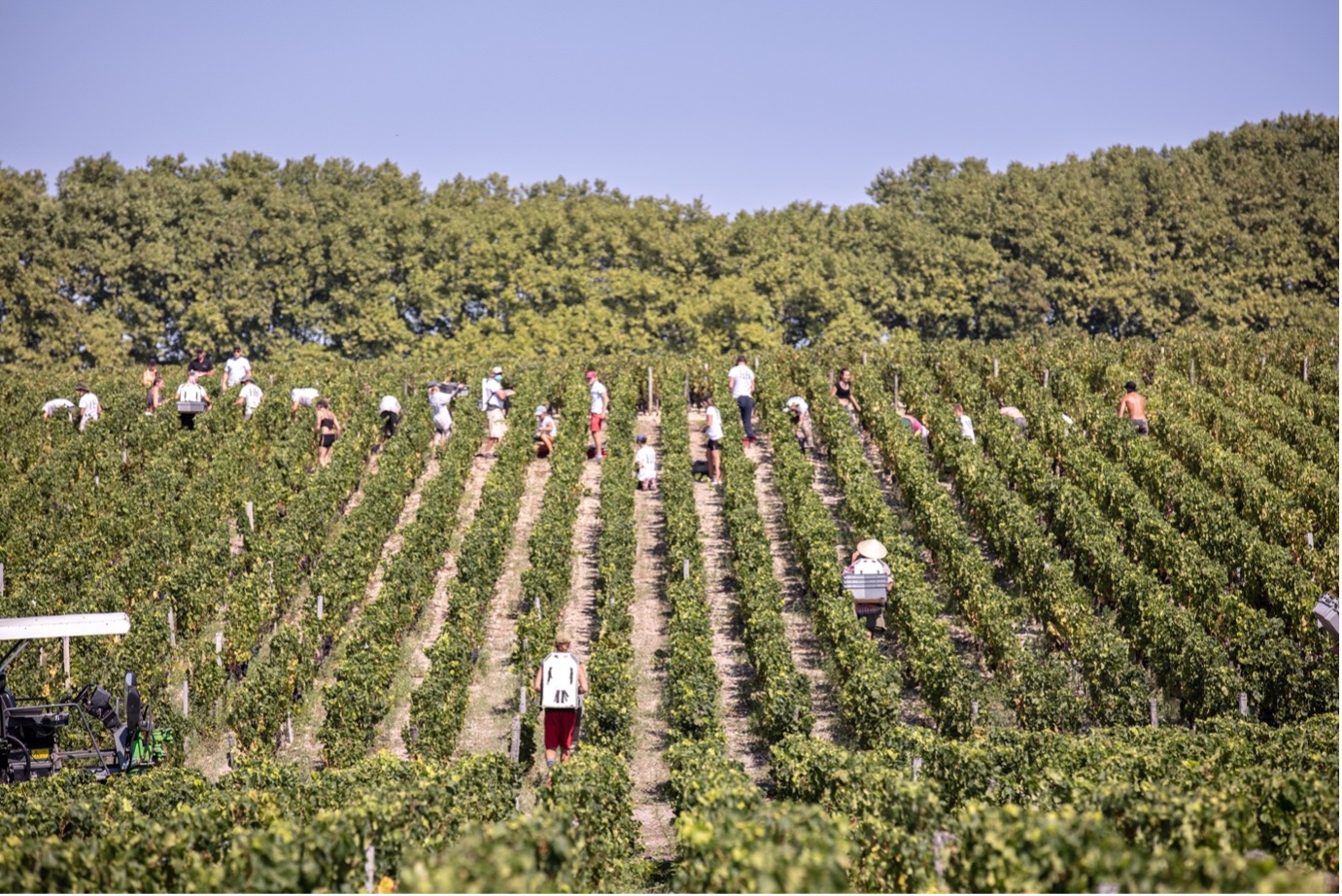 Haut-Bailly harvest under the scorching September sun
Haut-Bailly harvest under the scorching September sun
How is Bordeaux adapting to climate change?
Bordeaux has been no stranger to extreme climatic conditions in recent years, culminating in what some may describe as climatological confusion for many châteaux last year. While witnessing 15% more rainfall between March and September 2020 than its 30-year average for this period, Bordeaux also saw 54 days of excessive drought during the summer. It would appear that now, more than ever, adaptation and innovation are key to the successes of the region’s releases.
Dealing with drought
- Extensive dry spells have become a common phenomenon in Bordeaux, with Margaux’s Business Development Director, Alexis Leven-Mentzelopoulos, sharing with us his concerns that the vines “could end up with wilting” leaves, leading to “a loss in terms of yields but also eventually in terms of quality”. Despite also being one of the wettest years on record, 2020 was no exception with its pattern of heatwaves and ensuing drought.
- Saint-Émilion’s Cheval Blanc experienced its driest vintage since 1959, though Technical Director Pierre-Olivier Clouet explains the humid spring fortunately allowed the vines to accumulate “water and nutrients much needed later in the season”. He elaborates that despite the drought, this allowed vines to “grow calmly and homogenously”.
- Across the Gironde, Haut-Bailly’s Véronique Sanders tells us that “work in the vineyards has evolved enormously”, and that “the fundamental process of pruning has been re-examined” as part of a wider series of viticultural practices that have been changed to adapt to climate change, enabling Haut-Bailly to make the most out of the varied conditions.
Coping with concentration
- Several properties such as Larrivet Haut-Brion saw small and concentrated berries as a result of high temperatures and persistent drought in 2020. The estate’s Cellar Master, Charlotte Mignon tells us that it has had to adapt its winemaking in recent years, opting for punching down versus pumping over in order “to control light and elegant extractions” in such hot years.
- Alexis similarly tells us of Margaux’s recent investment in more highly advanced phenolic analysis equipment, which reports the levels of tannin and pigment in the individually-vinified lots and allows the team to “precisely plan extraction with lower temperatures, fewer and gentler pump-overs, and limited maceration time”.
- Increasingly concentrated grapes have also reduced yields across the region, as told to us by Calon Ségur’s Managing Director, Vincent Millet, whose volumes in 2020 fell to 33hl/ha (down from 40hl/ha in 2019) due to the heat.
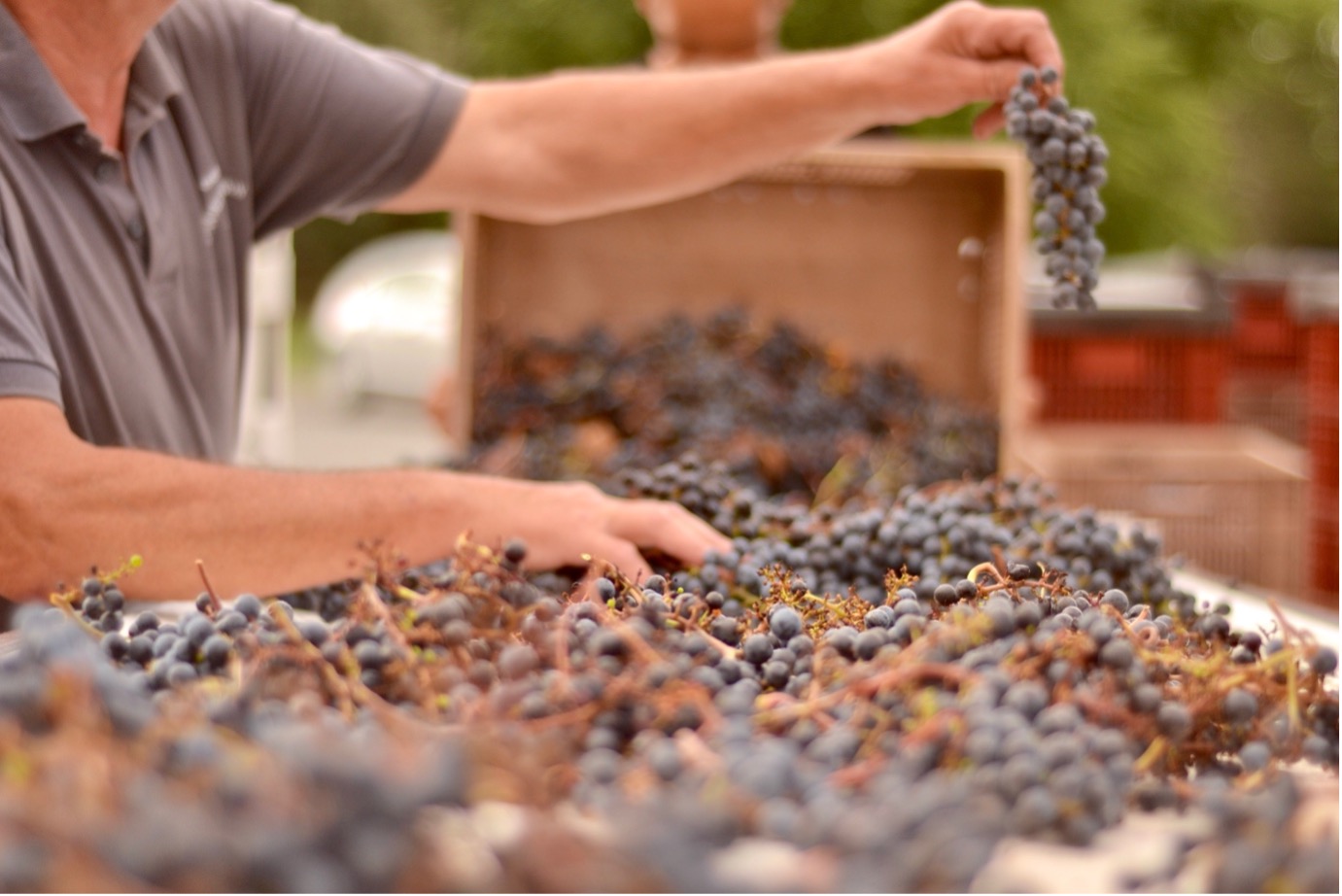 Larrivet Haut-Brion incorporating recently harvested whole bunches into their blend
Larrivet Haut-Brion incorporating recently harvested whole bunches into their blend
A move away from Merlot
- With global warming affecting the evolution of certain grape varieties, Palmer CEO, Thomas Duroux tells us that the “classic complex finish of Merlot” is particularly threatened by rapid ripening induced by hot summers.
- This concern was shared amongst several properties, with Charlotte finding Larrivet Haut-Brion’s Merlot grapes to be heavier, with greater sugar levels and thus a higher alcohol potential. To regain freshness in their Merlot juice, she now “incorporates the whole grape bunch, including the stalk”, to add more structure and tannins. In the long term, the estate is planning to replant more plots to Cabernet Sauvignon due to the varietal’s slower ripening, while Margaux is similarly including “more and more” Cabernet Sauvignon and Cabernet Franc in their blend, and “even thinking of perhaps experimenting with a few rows of Carménère”, to study how it reacts to high temperatures.
- In similar vein, Claire Villars-Lurton of Ferrière remarks on the advantage of less Merlot in the changing climate: “We have prioritised replanting of Cabernet Sauvignon, rather than Merlot, as even young the latter variety is more sensitive to water stress”.
Nourishing nature
- Several of the châteaux we spoke to highlighted their aim of counteracting the effects of climate change by enriching the natural environment and the soil. Thomas emphasises the importance of having a “living soil” in the face of ecological stress, noting that biological compost and plant growth amongst the vines offers “greater stability, root resilience, and nourishment” in increasingly hot and dry years.
- The benefits of a living soil are echoed by Vincent, who tells us that at Calon Ségur they plant grass cover in the vine rows maintains “some moisture in the soil during dry periods”.
- Claire notes that cover crops help to maintain soil biodiversity, but the approach she takes goes beyond this purpose: “we adopt a minimal intervention approach in the vines. We plant cover crops between the rows, that we fold over or cut so as to have a natural mulch – this protects the soil from the damaging effects of strong sunlight, allows the soil to keep a good level of humidity, and means any rain that falls can seep deeper into the subsoils”.
Shading from the sun
- Like several châteaux adapting viticultural practices vintage-by-vintage, Larrivet Haut-Brion withheld leaf removal until later in the 2020 growing season, to shelter grapes from the scorching sun.
- A similar strategy has been adopted at Haut-Bailly, who revise their canopy management every year to reflect the concurrent needs of vines.
- At Calon-Ségur, Vincent explains they are “careful about thinning out the leaves in order to avoid burns”, and are considering “adjusting the height of the trellis” to provide shade from one row to another. Opting for a more permanent solution, Margaux have gone so far as to “change the orientation of the vine rows” in order to “expose each side of the vine to the heat equally and minimize sunscald”.
As we approach the end of this busy Bordeaux en primeur campaign, yesterday (Wednesday 23rd June) saw the release of the Clarence Dillon family wines, Saint-Éstephe superstar, Montrose, and promising Pessac-Léognan pick, Haut-Bailly.
 A family affair: Wine Lister CEO, Ella Lister tasted the Clarence Dillon family wines in Bordeaux
A family affair: Wine Lister CEO, Ella Lister tasted the Clarence Dillon family wines in Bordeaux
Haut-Brion released its red and white grands vins at £433 and £600 per bottle respectively, with both wines receiving strong praise from critics in 2020. The former gains 97-99 points from Wine Lister’s partner critic Antonio Galloni (Vinous), who notes “The 2020 Haut-Brion is shaping up to be one of the wines of the year. […] Wow.” Wine Lister CEO, Ella Lister was also impressed, describing “Focussed purple fruits, with a fresh lift of aloe vera, pepper, and fading peonies” on the nose, with “Classical flavours of cassis and violet, [and] a beautiful, beamish balance” on the palate.
Ella also provides a positive perspective on the latest release of Haut Brion Blanc, describing an “almost Burgundian minerality” on the nose, a “golden” palate. It gains the joint-highest WL score of all dry Bordeaux whites in 2020, tying for first place with its cousin, La Mission Haut-Brion Blanc.
La Mission Haut-Brion’s red and white entered the market yesterday at £252 and £480 per bottle, respectively. Gaining an impressive score of 97-99 from Neal Martin (down from the potential 100-point score of 98-100 in 2019), La Mission Haut-Brion 2020 is described by the critic as “An enthralling wine in the making from Jean-Philippe Delmas and his team”. Ella is also impressed with the latest release, noting “brooding, poised aromas of pomegranate and fig” on the nose, with a “layered and expressive” palate. Falling under the current market price of the 2018 and 2019 (whose price has increased around 63% since its release), while sporting similar average critics scores to the 2015 and 2016 vintage, this could be an attractive buy.
Outside of the Clarence Dillon clan, Montrose entered the market at £128.35 per bottle, having been well received by the few critics who tasted in Bordeaux this year (the estate was among those that did not send samples abroad). Wine Lister’s partner critics, Bettane+Desseauve award 98 points on their new scale of 100 points, while James Lawther for JancisRobinson.com gives 18+ points. Tasting in Bordeaux, Ella notes that “The fruit this year is ethereal. Luminous, racy, and as with the second wine, with an incredibly gentle touch” on the nose, whilst the palate “has that Montrose silkiness in spades”. Gaining the highest WL score of Saint-Estèphe 2020s (96), this may well see demand from fans of the estate and its appellation.
Haut-Bailly also released yesterday at £96 per bottle, having gained positive scores of 95-97 from both Antonio Galloni and Neal Martin. Hosting a virtual tasting of the estate’s 2020s for our London office, owner Véronique Sanders told us that the château confronted extreme climatic conditions last year, akin to the past three vintages, which have all produced top quality wines. Indeed, tasting at the estate, Ella found Haut Bailly’s Grand Vin to be “poised, savoury, and relaxed” on the nose, with “a lovely weight, and trademark ribbon mouthfeel”.
As we find ourselves in the peak of this year’s en primeur activity, Tuesday morning (22nd June) saw a wave of releases from the Médoc and beyond, including wines from First Growth Margaux, its popular neighbour Palmer, and fellow biodynamic trailblazer, Smith Haut Lafitte.
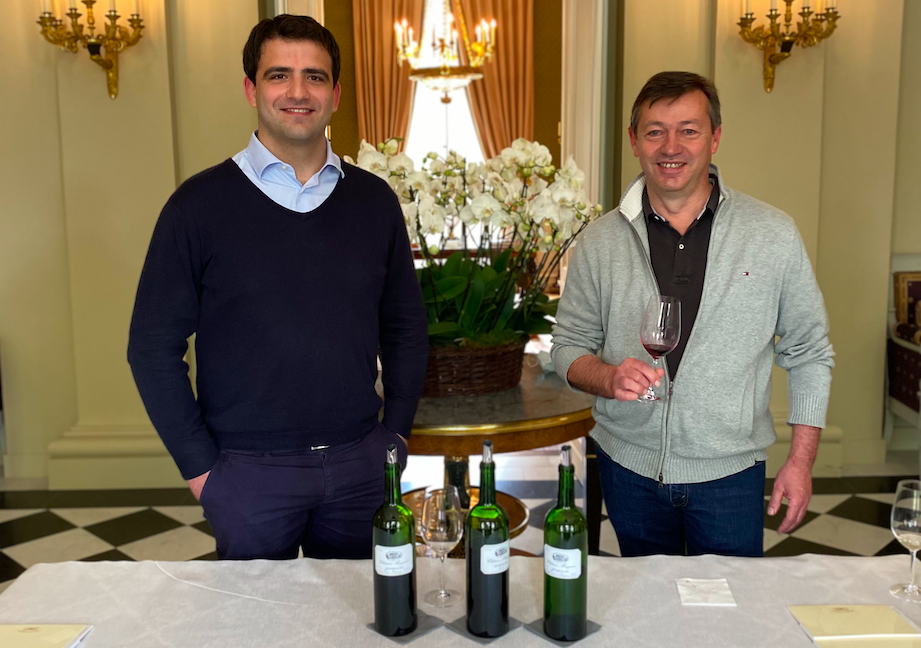 Moments at Margaux: the First Growth released its 2020 on Tuesday (22nd June) at £433 per bottle
Moments at Margaux: the First Growth released its 2020 on Tuesday (22nd June) at £433 per bottle
Smith Haut Lafitte kicked off the release rush, entering the market at £96 per bottle. The 2020 receives top scores across the board, with Wine Lister’s partner critics, Antonio Galloni and Neal Martin (Vinous) each giving 95-97 points, and the latter deeming it “an outstanding effort”. Tasting with co-owner, Florence Cathiard at the property, Wine Lister CEO, Ella Lister, describes “playful black fruit, dark chocolate, and black liquorice” on the nose, and a “fine-boned but monstrous tannic structure” on the palate.
Joining its red offering (at the same price), Smith Haut-Lafitte’s white also receives strong scores from critics, including 17.5 points from Jancis Robinson, who calls it “a real triumph”. Ella observes that the 2020 vintage is a perfect example of why Smith Haut-Lafitte is so famous for its blanc sec, finding “a subtle, flirtatious nose of white pepper, lime and pure white fruit”, and a “rich, creamy texture” on the palate. Both Smith Haut Lafitte 2020 rouge and blanc have special edition labels designed to celebrate the 30th vintage under Florence and Daniel Cathiard, as well as 655 years of the property.
Moving over to the Médoc, Margaux 2020 released yesterday at £433 per bottle, having been widely considered as the wine of the vintage. According to scores from Wine Lister’s partner critic panel, the First Growth does indeed top the 2020s, gaining the highest WL score of the vintage. Antonio Galloni and Neal Martin both award Margaux 97-99 points, with the former calling it “very clearly one of the wines of the vintage in 2020″. Tasting at the property in Bordeaux, Ella describes an “intensely rich, concentrated” nose, and a palate that is “off-the-charts potent in terms of fruit and acidity”. Wine collectors will likely be desperate to get their hands on this.
Margaux’s second wine, Pavillon Rouge, and dry white, Pavillon Blanc were also released, at £138 and £180 per bottle, respectively. Ella praises both wines in 2020, describing an “all-round beautiful balance and intensity of fruit” in the red, and admiring the “really rich, mouthcoating texture” of the white – “almost a Chardonnay-esque opulence”.
Popular en primeur pick, Palmer also entered the market at £240 per bottle. Speaking to Wine Lister in October, Managing Director, Thomas Duroux explained that while “négociants would have liked a vintage with high volume and lower prices, the 2020 will be small”, yet nonetheless “rich and exuberant”. Palmer 2020 receives strong scores from the few critics who have tasted it (having maintained its policy of not sending samples). James Lawther for JancisRobinson.com awards it 18+ points, while Ella comments on the wine’s “exquisite texture”, hailing it “like brushed Indian silk”.
Yesterday (Thursday 17th June) saw a flurry of promising releases from both banks, including the likes of Clinet, Pichon Baron, Pontet-Canet, Calon Ségur, and more. Below we examine some of the highlights.
 Alfred Tesseron getting a coffee at the Pontet Canet food truck during Bordeaux 2020 en primeur tasting week
Alfred Tesseron getting a coffee at the Pontet Canet food truck during Bordeaux 2020 en primeur tasting week
Clinet 2020 opened the stage for yesterday’s release rush, entering the market at £66.50 per bottle. Falling c.30% below the current average market price of last year’s release, which has seen strong price performance since, the 2020 receives good critical praise that places it qualitatively in line with both the 2019 and 2015. Tasting in Bordeaux, Wine Lister CEO, Ella Lister calls it the best Clinet she’s tasted, observing a “Graceful, silky-smooth entry into the mouth […] A triumph”.
Super-second, Pichon Baron followed closely behind, releasing its 2020 at £110.60 per bottle. Having also shown good price-performance in recent vintages, the latest release comes onto the market 5% below the current average price of the 2019, and 15% below the 2018. Wine Lister partner critic, Antonio Galloni (Vinous) awards the 2020 96-98 points, noting “This is hands down one of the most impressive wines of 2020”. Ella is also complimentary, describing a palate that is “Structured, voluminous at first”, then shows a “wonderful feather-lightness”.
Fellow Pauillac peer, Pontet-Canet also released yesterday at £74.23 per bottle, providing another discount on market prices for its 2019 and 2018 vintages (26% and 19%, respectively). Antonio Galloni gives the 2020 95-97 points (level with the 2019), calling it a “captivating effort from the Tesseron family” that is “luxuriously rich from start to finish.” Ella agrees with this optimistic assessment, describing “Characteristically unique aromas of black forest gâteau” on the nose, and a “sweet, and savoury” palate.
Rounding out the releases, Calon Ségur 2020 entered the market at £78.20 yesterday – 6% down on the remaining market availability of the 2019 (which has seen its price increase by around 28% since last year), and 27% down on the 2018. James Lawther for JancisRobinson.com awards the 2020 18 points, calling it “clean and saline on the finish”, while Ella describes “Iris, violet at the fore” on the nose, and a “moreish and elegant” palate.
Also released are: Pape Clément, Pape Clément Blanc, Pichon-Longueville Baron Les Griffons, Le Marquis de Calon Ségur, and Capbern.
The past two days have seen the 2020 campaign pick up speed, with more releases from Margaux, some promising picks from Pessac-Léognan, Pomerol, and Pauillac, as well as an entry from top Saint-Emilion estate, Ausone.
 Barrels of Lynch-Bages, whose 2020 vintage was released en primeur yesterday (Wednesday 16th June)
Barrels of Lynch-Bages, whose 2020 vintage was released en primeur yesterday (Wednesday 16th June)
Released on Tuesday (15th June) at £500 per bottle, Ausone 2020 is awarded strong scores from the small selection of Wine Lister partner critics who have tasted it. Akin to its Saint-Emilion Grand Cru Classé “A” neighbour, Cheval Blanc (who released its 2020 over a month ago), Ausone maintained its policy of not sending samples to critics abroad this year. Tasting at the property in Bordeaux, James Lawther for JancisRobinson.com awards it 18+ points (up from 17.5 in 2019 and 2018), while Wine Lister CEO, Ella Lister, is also positive, noting that it is “perhaps the mascot for the vintage of gentle power”.
Across the Garonne, Les Carmes Haut-Brion followed suit at £79 per bottle, having once again received successful ratings from critics this year. Wine Lister partner critic, Antonio Galloni (Vinous) awards the 2020 95-97+ points, calling it, “dazzling, but also a wine of reserve and understatement”, while Ella notes “a velvety, decadent crescendo” on the palate. The estate’s impressive price-performance post-en primeur release saw Les Carmes Haut-Brion 2020 enter the market 24% and 30% below market prices of the 2019 and 2018 vintages respectively, and sold out within minutes.
Top Margaux properties Brane-Cantenac and d’Issan also entered the market on Tuesday, at £50 and £42.20 per bottle, respectively. Neal Martin (Vinous) awards the former its highest score ever received from the critic body (95-97), and calls it “an absolutely fantastic Brane-Cantenac, in my mind superior to the previous two vintages”. Ella was also impressed with the 2020 vintage, describing the nose as “profound and complex” and observing “supple, lithe, thoroughbred (racé) tannins”.
Awarding 17.5 points, James Lawther for JancisRobinson.com calls d’Issan 2020 a “Classic Issan but with more aromatic complexity and a tad more length”, while Antonio Galloni (Vinous) gives his highest score to the estate since 2015, noting that it is “shaping up to be a jewel of a wine’. The latest release marks a historical year for the property, with the addition of three new grape varieties to its blend in 2020 (which comprises 55% Cabernet Sauvignon, 39% Merlot, and for the first time 3% Cabernet Franc, 2% Petit Verdot, and 1% Malbec). The critics’ praise across the board in 2020 suggests that the additional varieties have indeed achieved Emmanuel’s goal of “creating more complexity”.
Released yesterday (Wednesday 16th June) at £134.50 per bottle, Pichon Comtesse 2020 was awarded 96-98 points from Neal Martin (Vinous), who describes “a magnificent, cerebral Pichon-Lalande”. Ella is similarly optimistic about the latest vintage, noting “energetic fruits that span the colour palette from black to red.” Pichon Comtesse’s successful 2019 vintage has seen its price increase by over 50% since its release last year, which should encourage interest in the 2020.
Popular Pauillac powerhouse Lynch-Bages also entered the market yesterday, and merchants have been offering the wine for just under £87 per bottle. Tasting in Bordeaux, Ella found it to be “monumental as it first hits your nostrils” with a palate that “ boasts focussed, tart, crunchy red fruit, with a subtle toastiness on the finish”. The estate’s strong brand strength and loyal following, particularly on the UK market, will likely help the 2020 find buyers, not to mention that 2020 is the first vintage made in the property’s long-awaited new cellar.
Also released during this period are: Malescot Saint-Exupéry, Nénin, Réserve de la Comtesse, Pibran, Echo de Lynch-Bages, Blanc de Lynch-Bages, Trotte Vieille, Chapelle d’Ausone, and Blason d’Issan
With en primeur releases steadily gaining momentum this week, the campaign has been propelled forward today (Friday 11th June), as we see the first release from a First Growth: Lafite and its associated wines.
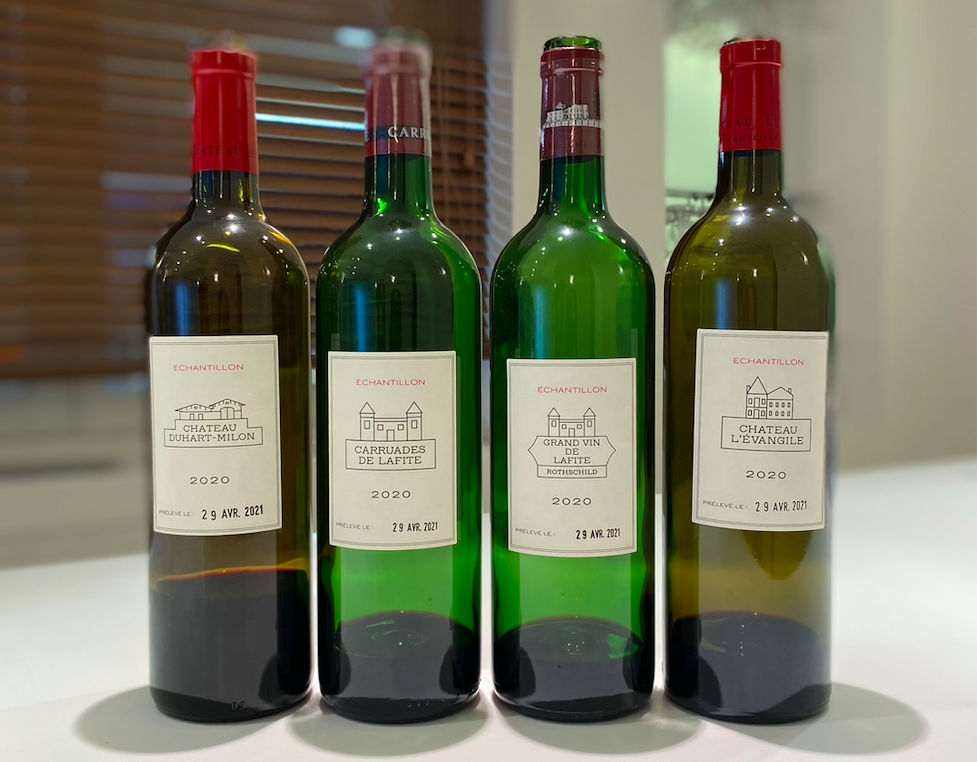
Duhart-Milon hit the ground running at £57 per bottle. The château has seen significant investment over the last 10 years, and with its vineyards on cool sites, it has flourished over the past few, warmer vintages. Tasting the Lafite line-up alongside International Director of DBR, Jean-Sébastien Philippe, Wine Lister CEO, Ella Lister, found Duhart-Milon 2020 to be “rivetingly pure, lifted, [and] eager” on the nose, with a “bouquet of spiced plums, black liquorice, chocolate-orange, and fresh flowers”. Marking the first vintage made in the property’s new winemaking facility in the heart of Pauillac town, this is a promising buy for lovers of the appellation.
Carruades de Lafite followed in quick succession, entering the market at £177 per bottle. Jean-Sébastien explains that owner Saskia de Rothschild considers Carruades to be the “promise of Lafite” – from vines that might one day have the potential to provide for the Grand Vin. Cutting volumes by half over the last few years is just one of the steps taken to increase the second wine’s quality. Described by Ella as “A mysterious Carruades, with a nose that is sultry and flirtatious”, the 2020 vintage comes onto the market comfortably under all recent back vintages available.
Lafite’s Pomerol property, L’Evangile released its 2020 grand vin at £185 per bottle. Alongside its left bank siblings, the estate has been undergoing its own transformation over the past few years, complete with a new winemaking team. Set to be certified organic from 2021, it already employs many biodynamic principles. Wine Lister’s partner critics Neal Martin and Antonio Galloni (Vinous) award the latest release 94-96 and 95-97 points respectively, with the latter stating “The 2020 L’Evangile is fabulous. […] Don’t miss it!”.
To end the release rush on a high, Lafite takes the first leap for the First Growths with a vintage that scores well across Wine Lister’s partner critics. Playing into the movement of a more restrained style of Bordeaux, Lafite 2020 sports the lowest alcohol percentage since 2010 (of 12.8%), and a low pH of 3.5. Writing for JancisRobinson.com, James Lawther awards it 19 points, noting its “Incredible potential”, while Ella comments that “the high acidity will carry it long into the future, gracefully, balletically. This is no monster, but rather soft and delightful”. As ever with Bordeaux’s super-brand, competition to access Lafite 2020 will likely be high.
 Palmer’s Director, Thomas Duroux tasting Palmer 2011 and Alter Ego 2017 with Wine Lister CEO, Ella Lister
Palmer’s Director, Thomas Duroux tasting Palmer 2011 and Alter Ego 2017 with Wine Lister CEO, Ella Lister



 From left to right: Lupo Theones, Victor Petiot, Gareth Ferreira, Beatrice Bessi, and Paul Lo
From left to right: Lupo Theones, Victor Petiot, Gareth Ferreira, Beatrice Bessi, and Paul Lo  From left to right: Stefan Kobald, Victoria O’Bryan, Julien Sarrasin, Jonathan Charnay, and Pascaline Lepeltier
From left to right: Stefan Kobald, Victoria O’Bryan, Julien Sarrasin, Jonathan Charnay, and Pascaline Lepeltier

 A family affair: Wine Lister CEO, Ella Lister tasted the Clarence Dillon family wines in Bordeaux
A family affair: Wine Lister CEO, Ella Lister tasted the Clarence Dillon family wines in Bordeaux


